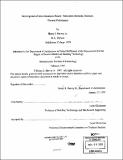Development of straw insulation board : fabrication methods, structure, thermal performance
Author(s)
Harvey, Henry S. (Henry Stimson)
DownloadFull printable version (11.65Mb)
Advisor
Leon Glicksman.
Terms of use
Metadata
Show full item recordAbstract
Insulation board is being fabricated and tested for use in developing countries. It is made at a low density, in the area of 5 to 10 pounds per cubic foot (80 to 160 kilograms per cubic meter), and has good thermal properties for an air based insulation, meaning R3 to R4 per inch (Btu-in/ hr-ft2-°F)-, or a conductivity of .048 to .036 W/m-K. The initial effort is to produce a straw insulation board suitable for northern Pakistan, where we are studying the needs and construction of schools and houses. Some type of rigid insulation is needed, as opposed to loose fill, because the buildings have solid masonry walls without an air gap. These boards will be suitable for other developing countries as well The initial survey of possible methods included 1) containing the straw in panels with wire and battens, 2) pulping the straw, and 3) binding with adhesive. In this latter category starch, PVA and sodium silicate were tried as adhesive using uncut and shredded straw, with various methods of application such as spraying, foaming, and dipping, at various adhesive loading rates. Small samples were formed at a range of densities to test structural and thermal properties. This survey suggested that all three of these approaches can succeed structurally and thermally, but that competing economically with existing insulation board is difficult. For boards with binder, the adhesive efficiency was poor. In the final phase of the project, a batch of boards was made at ICI Polyurethane's North American research and development facility, using methane di-isocyanate as the binder. The boards, made at a range of densities and resin contents, and using straw with and without the fine particles, were tested thermally and structurally at MIT. Good mechanical properties were obtained at resin contents as low as 2% by weight. At densities of 8 and 10 pounds per cubic foot (pcf), these boards have R values of 3.7 and 3.45 per inch, respectively. The pressure required to compress the 10 pcf boards to 10% of their original thickness is approximately 15 pounds per square inch (psi), and the modulus of rupture in bending is in the range of 50 psi. Removing the fine particles from the straw improved board strength markedly. These boards at a density of 10 pcf and 2 to 4 % resin content have an estimated materials cost of 2 [cents] per insulating unit (R-ft2), substantially less than either the cost of the expanded polystyrene available in Pakistan, or the retail cost of any rigid board insulation sold in North America.
Description
Thesis (S.M.)--Massachusetts Institute of Technology, Dept. of Architecture, 1997. Includes bibliographical references (p. 66-69).
Date issued
1997Department
Massachusetts Institute of Technology. Department of ArchitecturePublisher
Massachusetts Institute of Technology
Keywords
Architecture